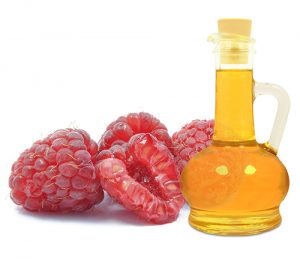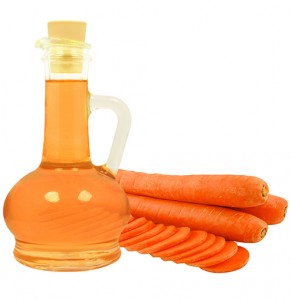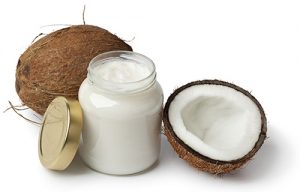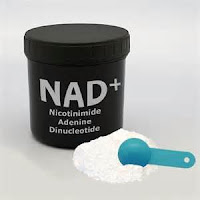you can listen-in for a summery of this article by clicking on the blue button below:
Over the past few years, the anti-aging community has been abuzz about a unique chemical compound called Nicotinamide Adenine Dinucleotide, [American] nicoti-namide ade-nine d-in-u-cleotide or NAD+ for short.
In one landmark study, Harvard researchers were able to use NAD+ to make the cells of 2 year old mice look like the cells of 6 month old mice.
Is NAD+ really the secret cure for aging? Can you take NAD+ supplements to reverse the effects of aging on your body and mind? Let’s find out today in our NAD+ review.
What is NAD+?
NAD+ is the shortened name of nicotinamide adenine dinucleotide. It’s a chemical compound used by every cell in your body.
In fact, NAD+ is found in every living mammal.
Researchers have found that NAD+ levels are directly related to aging: as we age, levels of NAD+ decline, so there’s an inverse relationship between aging and NAD+ levels.
Interestingly enough, NAD+ levels decline in everybody as they age. Regardless of your personal health, diet, or physical fitness, your NAD+ levels will decline as you age.
The idea behind NAD+ is that we can artificially raise these levels and trick the body’s cells into thinking we’re younger. If you’re experiencing fatigue, lack of motivation, and age-related physical or mental decline, then NAD+ supplementation has been proposed as a cure.
Chemically speaking, there’s a difference between NAD+ and other forms of NAD. NAD is a coenzyme found in all living cells, and NAD+ is the oxidized form of NAD. There are also compounds like NADH, the reduced form of NAD, NA, NAM, NR, and NAD – all of which act as precursors or building blocks for NAD+.
How Does NAD+ Reverse the Effects of Aging?
Generally speaking, NAD+ enables the transfer of energy from the foods we eat to our cells. When our cells need to perform essential functions, they ask our blood for energy in the form of glucose and fatty acids. NAD+ helps get that glucose where it needs to go, giving us better physical and mental energy.
NAD+ has been linked with a number of powerful biological processes.
These processes reverse the effects of aging by making your cells look – and act – younger:
— Promote Sirtuin Gene Activation (using SIRT1 and SIRT3)
— Enhance The Growth And Efficiency Of Mitochondria, Which Boosts Physical And Mental Energy Throughout The Body
— Optimize Metabolism
— Enhance Cognitive Health And Reverse The Effects Of Aging On The Brain
— Enhance Cognitive Health And Reverse The Effects Of Aging On The Brain
— Reverse On The Brain
— Promote Insulin Sensitivity And Encourage Healthy Blood Sugar Levels
— Repair DNA
Together, these benefits reverse the effects of aging in every cell of the body. As we age, levels of NAD+ decrease. This makes it difficult for cells to process the energy they need – their mitochondrial function is severely impaired.
Mitochondrial depletion in every cell of the body is one of the major reasons behind the physical symptoms of aging. Declining NAD+ and mitochondrial function leads to neurodegeneration, vascular inflammation, increased fat storage, increased fat production, insulin resistance, fatigue, and loss of muscle strength.
Scientific Evidence for NAD+
Scientific evidence has been mounting in support of NAD+. More and more studies are being done every year on this exciting new compound. In 2003, there were 474 studies published on niacinamide. In 2013, there were 1,713.
How Much NAD+ Should You Take?
Before buying an NAD+ supplement online, be sure to check the dosage per serving. Most NAD+ pills appear to have a formula containing less than 100 mg of NAD+. In reality, you want at least 1000 mg (1 gram) or more in order to see any benefits.
Alternatively, use vitamin B3: there’s a form of vitamin B3 that acts as a precursor to NAD+. Specifically, the type of vitamin B3 called nicotinamide riboside has been found to increase NAD+ levels.
The Food and Nutrition Board recommends a daily intake of 14 to 18 milligrams for niacinamide and niacin, with the upper intake level being 35 mg per day.
However, that upper intake level is routinely exceeded when taking niacinamide for various conditions. When taken to prevent age-related eye disease, patients take up to 500 mg by mouth. When taken to prevent clogged arteries, patients take 3,000 to 4,000 mg by mouth.
And when taken to prevent heart disease, patients take anywhere from 0.125 to 12 grams of niacin by mouth daily for up to five years.
Many people follow these general guidelines when deciding how much NAD+ to take. Most of the benefits from niacin supplementation occur after doses of at least one gram.
Always talk to your doctor before taking an NAD+ supplement.
Conclusion: Who Should Take NAD+?
The field of study around NAD+ is still very new. Many studies have been performed already, and most of those studies have been overwhelmingly supportive of NAD+ and its health benefits.
Unfortunately, the NAD+ supplements you see on the market today don’t typically provide the benefits.
NAD+ could legitimately be the cure for aging: more research needs to be done, and more research is being done. Unless you can find an NAD+ supplement which offers a dosage higher than 1 gram, then the NAD+ supplements you see on store shelves or on Amazon aren’t worth your time or money.
Article From: http://supplementpolice.com/nad/
Article From: http://supplementpolice.com/nad/
REWIND YOUR CELLULAR CLOCK, RESTORE YOUR HEALTH
Even more significantly, the researchers found that when higher levels of NAD+ were introduced back into the cells, the aging process was actually reversed—after only a week of treatment with a compound that stimulated NAD+ production, tissue samples taken from mice that were two years old showed the same youth and vitality of mice that were only a quarter that age.
In humans, this is roughly equivalent to taking someone 60 years old and turning back the cellular clock until they look like they’re in their 20s!
It isn’t as simple a smearing on a cream or taking a pill and instantly becoming younger, of course, but in terms of restored cellular function and thus restored health, vitality, and capability, the NAD+ treatment is very real and very effective. A supplement that helps promote NAD+ production in humans could have the same effects, making older cells function and behave just as they did in their youth.
This in turn would lead to more youthful bodies and minds. Reversing the cellular aging process could reduce or eliminate many of the joint aches and pains associated with growing older, improve memory and other cognitive functions, improve the results people in their 50s and beyond see from weightlifting and other exercise, and restore the health we all used to take for granted in our 20s.
And here’s the best news yet: there’s already a supplement available, and it starts working in as little as eight hours after the very first dose. Below are the 2 very best sources:


Check out the supplements and shop here
Click Here for Best deal on NAD+
TRU NIAGEN Shop Now here
Why you should not use Coconut Oil as a Sunscreen
If you are a follower of DIY natural skincare blogs or Pinterest, you may have tried making your own coconut oil sunscreen. Or you may have seen recommendations and pictures telling you that you can substitute your sunscreen by raspberry seed oil, carrot seed oil, coconut oil, shea butter and many other common and exotic plant oils and extracts. With the huge surge we see in people making their own natural skincare products all around the world, it’s not surprising that the idea of being able to make your own sunscreen products is very tempting.
Unfortunately you can’t provide a good evenly distributed verifiable Sun Protection Factor (SPF) with a DIY recipe. In fact, making your own sunscreen is complicated, challenging and expensive. In some parts of the world, products which contain a SPF are viewed as pharmaceuticals And even in those parts of the world where they are viewed as cosmetics, they still require rigorous and expensive testing.
Quick Re-Cap on SPF
The Sun Protection Factor (SPF) scale is measured by a sunscreen’s ability to prevent UVB from damaging the skin. If it takes 20 minutes for your unprotected skin to start turning red, then using a SPF 15 sunscreen theoretically prevents reddening 15 times longer – about five hours.To quote the Skin Cancer Foundation:
Another way to look at it is in terms of percentages: SPF 15 filters out approximately 93 percent of all incoming UVB rays. SPF 30 keeps out 97 percent and SPF 50 keeps out 98 percent. They may seem like negligible differences, but if you are light-sensitive, or have a history of skin cancer, those extra percentages will make a difference. And as you can see, no sunscreen can block all UV rays.
But there are problems with the SPF model: First, no sunscreen, regardless of strength, should be expected to stay effective longer than two hours without reapplication. Second, “reddening” of the skin is a reaction to UVB rays alone and tells you little about what UVA damage you may be getting. Plenty of damage can be done without the red flag of sunburn being raised.
3 Reasons why you should not use natural oils as sunscreen
Why can your sunscreen not be replaced by these oils and butters? Why can’t you make a simple coconut oil sunscreen and be protected from the sun? We’ve summarised 3 important reasons as to why natural oils are no substitute for a properly formulated suncare product with a verifiable and measureable SPF:1. Natural oils do not absorb UV sufficiently
Researchers in one study (Gause & Chauhan, 2016) found that natural oils are not suitable UV-blocking ingredients. They measured the UV absorptivity of aloe vera, canola oil, citronella oil, coconut oil, olive oil and soya bean oil and found that all of them did virtually nothing when it came to blocking UV. They concluded that their SPF would be very close to 1. This effectively means that these ingredients will do nothing to prevent reddening. Another study by Kaur & Saraf (2010) found slightly higher values for certain botanical oils, but these were still no higher than 7 at best and 1 at worst.2. Natural oils do not absorb UV at the right wavelengths
In the Gause & Chauhan study we referenced above, Vitamin E was the only substance which showed appreciable UV absorbance, but this only occurred below a wavelength of 310nm which still allowed most of the UV spectrum to pass through unblocked. Sunlight’s UVB-UVA range is 290-400nm.3. Natural oils have not had their SPF tested and verified for sunscreen use
Natural botanical oils have not gone through the lab and human testing required to establish their SPF. The CTPA has published a great infographic to show you exactly how a sunscreen product is tested and brought to market. In short:- You start out by deciding what SPF you want to achieve. You then choose the correct SPF blocker in order to get to that level.
- The sunscreen is then tested in the lab multiple times during the development process to ensure that the SPF is still on track.
- The sunscreen is then tested on human volunteers who are exposed to a specific amount of sunlight. Their skin reaction is then assessed.
- The lab then compares these results with their test results to ensure the SPF matches.
The Myth of Raspberry Seed Oil SPF
 We found a study by Oomah et al., 2000 in the Journal of Food Chemistry which claims that raspberry seed oil has a high SPF. The study makes the bold claim: “The optical transmission of raspberry seed oil, especially in the UV range (290±400 nm) was comparable to that of titanium dioxide preparations with sun protection factor for UVB (SPF) and protection factor for UV–A (PFA) values between 28-50 and 6.75-7.5, respectively (Kobo Products Inc., South Plainfield, NJ)”.
We found a study by Oomah et al., 2000 in the Journal of Food Chemistry which claims that raspberry seed oil has a high SPF. The study makes the bold claim: “The optical transmission of raspberry seed oil, especially in the UV range (290±400 nm) was comparable to that of titanium dioxide preparations with sun protection factor for UVB (SPF) and protection factor for UV–A (PFA) values between 28-50 and 6.75-7.5, respectively (Kobo Products Inc., South Plainfield, NJ)”.The study then does not provide any reference to any studies to underpin this research. You might also notice that there is an enormous range between a SPF of 28 and 50 which suggests that no formal SPF testing has been undertaken on this oil. And yet this study has gone round the world multiple times, being quoted on blogs, on DIY skincare courses, on Pinterest and even on skincare ingredient retailers’ websites. We would hazard a guess that the authors of the Oomah study would not have published this throw-away statement if they would have understood the implications of this one sentence. Please do not take this one line as confirmation that raspberry seed oil has any kind of SPF.
The Myth of Carrot Seed Oil SPF
 Similar
to raspberry seed oil, some members of the DIY community claim that carrot seed
oil can have a SPF of 38-40. After some digging on Carrot Seed Oil last year I
and quoted a strong rebuttal from well-known essential oil expert
Robert Tisserand who also verified that carrot seed oil would not have
such a high SPF.
Similar
to raspberry seed oil, some members of the DIY community claim that carrot seed
oil can have a SPF of 38-40. After some digging on Carrot Seed Oil last year I
and quoted a strong rebuttal from well-known essential oil expert
Robert Tisserand who also verified that carrot seed oil would not have
such a high SPF.We found that these figures for carrot seed oil most likely come from a 2009 Indian study where the researchers tested the photostability of a sunscreen product which contained carrot – they did not test carrot by itself. We don’t know in what form the product contained carrot and we also don’t know what the other ingredients were – so it is unlikely that carrot seed oil by itself has a SPF of 38-40. In fact, in some folklore recipes carrot juice and carrot seed oil are used as homemade self-tanning products which accelerate your tan when exposed by the sun.
This blogger at Gwen’s Nest did some further sleuthing and determined that the sunscreen most likely tested was the Biotique Bio Carrot SPF 40+ which does not list its full ingredients on the website or on the packaging. It also contains zinc, which is most likely the UV blocking ingredient in the formulation.
It is important to remember that there are different types of oil products which contain carrot so there is also no clarity on whether this refers to a maceration of carrot in oil, steam distilled carrot seed oil, carrot seed CO2 extract or perhaps even (very rare) cold pressed carrot seed oil.
The Myth of Coconut Oil SPF
 Finally,
coconut oil is one of the other most often quoted sunscreen oils in the
DIY community. You may see mentions of coconut oil having a SPF of 7,
which may give the impression that it’s still possible to use neat
coconut oil sunscreen for a short period and be safe in the sun.
Finally,
coconut oil is one of the other most often quoted sunscreen oils in the
DIY community. You may see mentions of coconut oil having a SPF of 7,
which may give the impression that it’s still possible to use neat
coconut oil sunscreen for a short period and be safe in the sun.This 2016 study in the International Journal of Cosmetic Science refutes that and shows that coconut oil has a SPF of 1. Other studies may show slightly higher results and we all know that one study is not necessarily conclusive on its own, but that doesn’t mean you should take any risks with your skin when it comes to the sun. Coconut oil should not be used as a stand-alone sunscreen.
Why making your own natural sunscreen is challenging
Nonetheless, botanical oils and extracts can play an interesting additional role in any sunscreen. Certain studies (Ramos et al., 1996; Gause & Chauhan, 2016 – and others) have found that some extracts can boost the UV blocking potential of the overall sunscreen formulation. This finding suggests that it’s possible that the total amount of chemical sunscreen agents required in the formulation could be reduced (not replaced) by using UV blocking boosters.But to get to that stage, you will still need to formulate an effective sunscreen with a measurable SPF and you will need to go through extensive in vitro and in vivo testing. Even then you are not guaranteed to achieve the SPF you want – we enjoy this article by Personal Care Truth on the trouble with making your own sunscreen.
Working with verified and tested sunblocking ingredients such as zinc oxide and titanium oxide is still complicated and does not guarantee a specific SPF. The efficacy and real SPF of your finished sunscreen not only depends on how much of these ingredients is used in the formulation, but it also depends on how the ingredients are distributed. You cannot use a simple formula of e.g. 30% zinc oxide = SPF 30 because you will nearly always be wrong. This is why each batch of your sunscreen must be tested on humans once the formulation has been verified and gone through each of the elaborate lab testing stages we mentioned above.
We are huge fans of natural ingredients and we can only wish that it was true that a botanical oil on its own can provide the same level of protection as a formally tested suncare product. It would be great if you really could simply whip up a batch of coconut oil sunscreen and protect your skin adequately. But there are no shortcuts when it comes to formulating suncare products and we strongly encourage you to stay safe in the sun.
How You Can become A Sponsor https://www.advertisecast.com/37






No comments:
Post a Comment
no comments allowed
Note: Only a member of this blog may post a comment.